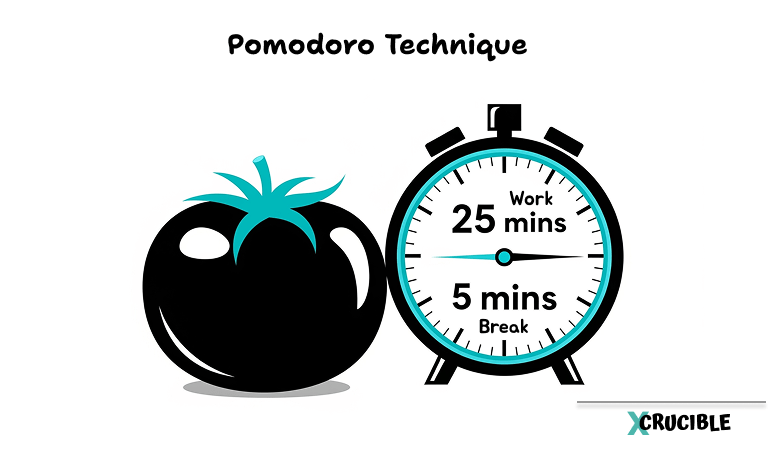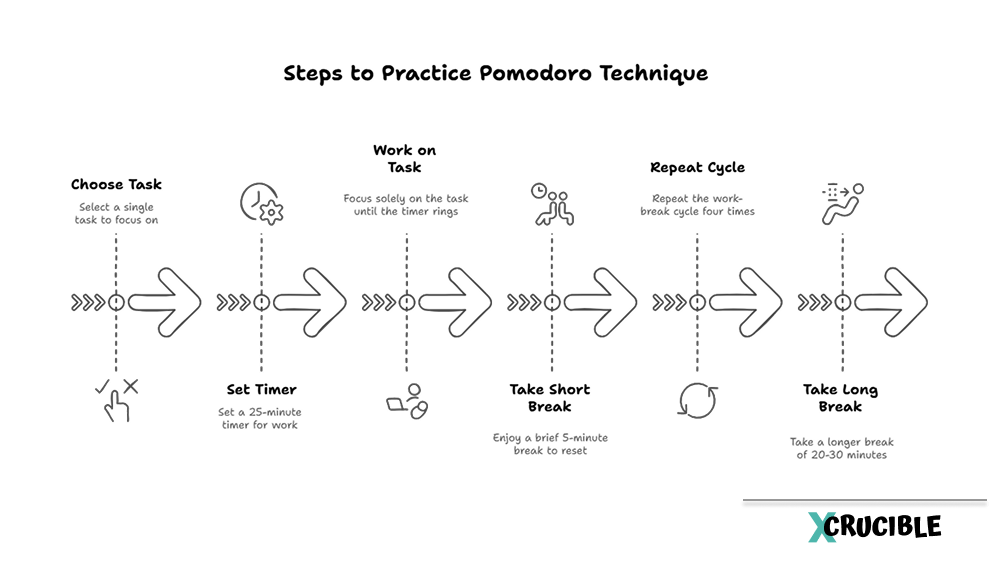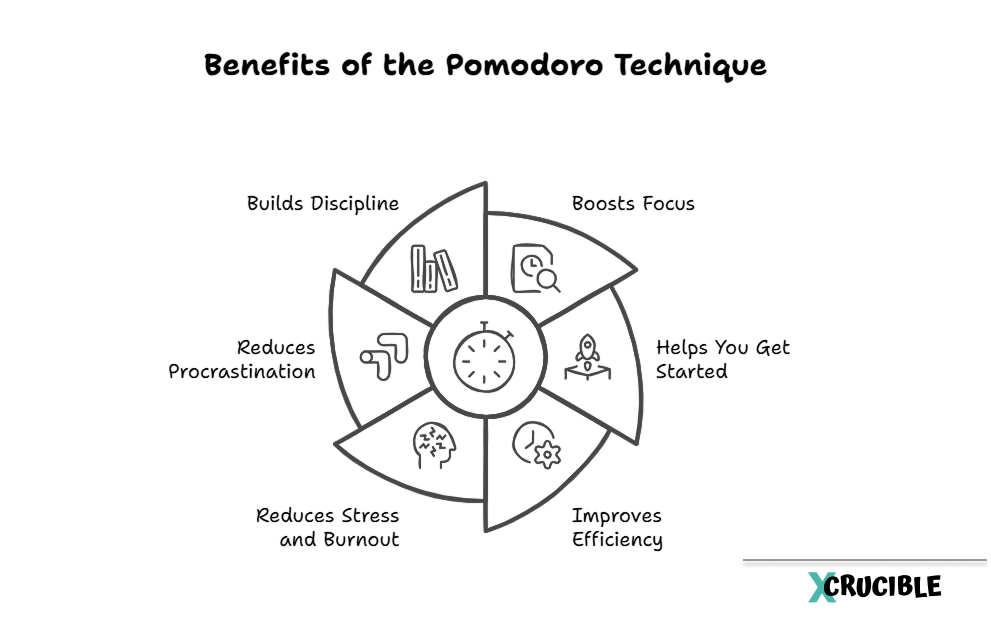Let’s be real—our attention span today is shorter than ever. Between constant notifications, endless tabs, and a long to-do list, staying focused feels nearly impossible.
That’s where the Pomodoro Technique steps in.
What is the Pomodoro Technique?
The Pomodoro Technique is a time management method that helps you stay focused and accomplish more work.
You pick one task, set a timer for 25 minutes, and work without any distractions. When the time is up, take a short break of 5-10 minutes. After four such sessions, take a longer break of 15-20 minutes.
This cycle helps you stay fresh, motivated, and make steady progress without getting overwhelmed.

In short: Work for 25 minutes. Take a 5-minute break. Repeat it 4 times. Take a 30-minute break. As simple as that.
So, what does Pomodoro mean? Let’s get into a bit of history for that!
Origin and History
The Pomodoro Technique was created in the late 1980s by Francesco Cirillo, a university student at the time. He was struggling to stay focused (like many of us) and decided to use a kitchen timer to manage his study sessions.
The timer he used was shaped like a pomodoro, which means “tomato” in Italian. That’s how the technique got its name.
Francesco started by setting the timer for 10 minutes and challenging himself to work without distractions. Over time, he refined the method into 25-minute sessions followed by short breaks. It worked so well for him that he turned it into a full productivity system that many people still use today.
Does it Really Work?
Yes, for many people—it really does. And there’s some science behind why.
The idea is simple: Our brains aren’t built to focus without any gap for hours. Studies show that after about 20–30 minutes, our attention naturally starts to fade. The Pomodoro technique works alongside this. It helps you stay focused for a short time, then gives your brain a quick break to reset. What makes it so effective is that it builds consistency without overwhelming you.
More than just a technique, it’s a mindset shift: from “Ugh, I have so much to do” to “Let me just start.” Trust me, that small change often makes the biggest difference.
In short: yes, it works—when you make it work for you.
How to Practice the Pomodoro Technique (Step-by-Step)
The Pomodoro technique is so simple and easy to follow. Here’s a step-by-step guide for you to get started:

Choose your task
Pick one task you need to work on. Yeah, just one. Think about the next task after completing it. Keep all your distractions away— mute all the unwanted notifications, and put your phone on “do not disturb” mode.
Set timer for 25 minutes
Once you are ready, set your timer for 25 minutes. You can use your phone or a physical timer, or any online apps available. It’s just 25 minutes—treat it like a challenge to stay locked in, no distractions.
Work on the task
No checking your phones. No multitasking. Just give your complete attention to the task until the timer rings. If something pops your mind in the middle, write it down and keep it aside for later.
Take a Short break
Timer rings? Stop working—yes, even if you are in the middle of something. Enjoy your break—walk around, sip some water, or just breathe. These short breaks help you reset your brain and prevent you from burning out. Don’t skip this.
Repeat the cycle
Hit restart! Work again for another 25 mins and take a short break. Repeat this cycle four times consistently—’consistency’ is all that matters. Keep the momentum going.
Take a long break
After every four Pomodoros, take a longer break—around 20 to 30 minutes. Think of it as your mental reset button. This allows you to refresh and recharge before starting again.
That’s it. Super simple, right?
You don’t need more time. You just need more focused time.
Customizing your Pomodoro
While the traditional technique involves 25 minutes of work intervals and 5 minutes breaks, there isn’t any strict rule to stick with it. You can customize it according to your workflow and energy levels. It is best to decide based on the kind of task.
For example, writing and coding kind of tasks might need a bit longer sessions, and admin tasks might need less.
Pro Tip: Find your focus time
Here’s a simple way to figure out your ideal work interval:
- Set a stopwatch.
- Pick a task and start working.
- Stop it as soon as you feel your focus slipping.
That’s your natural focus time. For more accuracy, repeat this a few times (maybe three to five), and average it. Let’s set that as your work interval.
If your focus time is greater than 25 minutes, good enough.
If less than that, no worries. Start there and increase gradually.
Tips for maximum productivity
Let me add on some quick tips to make your Pomodoros more effective:
Plan your tasks first
Know what you’re working on before you start the timer.
Cut out distractions
Silence your phone, mute notifications, close unused tabs.
Break big tasks into smaller chunks
Clear steps help you stay on track.
Take your breaks seriously
Step away, even if you’re in flow. It keeps you sharp.
Track your sessions
Helps you measure progress and stay motivated.
Benefits of the Pomodoro Technique
Here are the key benefits you’ll get from using the Pomodoro Technique:

Boosts Focus
When you know the clock is ticking, you naturally start working. It creates a subtle sense of urgency. Short, timed sessions train your brain to lock in and improve your focus—with no room for distractions.
Helps you get started
Starting is often the hardest part—especially when a task feels too big. This technique makes it feel manageable by taking the pressure off. Think about just one session at a time, not the whole task, and you’ll feel like “Let’s do this.”
Improves efficiency
The work-break rhythm helps you get more done in less time. It also enables you to plan better and stop underestimating your time—avoiding last-minute chaos. You’ll get to know where your time really goes!
Reduces stress and burnout
Frequent breaks keep your energy level steady and prevent you from burning out. Most importantly, it gives your brain permission to rest—without the guilt that often comes with stepping away from work.
Reduces Procrastination
Tasks feel less exhausting when broken into pieces, giving you the motivation to start. It’s way easier to start small than to keep delaying. Bit by bit, it builds the habit of showing up and staying on track.
Builds Discipline
Every completed Pomodoro feels like a win. And those wins stack up. That sense of progress keeps you going—even on days when motivation is low. No more “I’ll start in 5 mins.”
Drawbacks to keep in mind
While the Pomodoro Technique works well for many, it’s not perfect for everyone or every situation. Here are some potential downsides to keep in mind:
- The fixed time blocks can sometimes feel like “too rigid”.
- Not ideal for jobs with frequent meetings, collaboration, or unpredictable interruptions.
- Might push down your creativity by imposing a “get it done fast” mindset.
- Sometimes, you might focus more on finishing sessions than on the quality of your work.
Common mistakes to avoid
Take a look at the common mistakes to avoid when using the Pomodoro technique:
- Breaks are just as important as working; skipping them could lead to mental overload.
- Setting unrealistic goals and trying to do so much in one session could cause frustration.
- Applying the same 25/5 minute rule to all tasks might not work.
- Using breaks to scroll social media can leave you more tired or distracted than before.
Tools and Apps
There are numerous Pomodoro timer apps and tools available for both smartphones and computers. Here are a few:
Forest: A fun, visual timer where a tree grows as you stay focused—and withers if you leave the app. Perfect if you’re trying to stay off your phone while working.
Pomofocus: A minimal, distraction-free web timer. It’s easy to use and shows session history, which helps with reflection and tracking.
Focus To-Do: A clean, simple app that combines Pomodoro timing with task lists. Great for organizing your day while staying on track with your sessions.
Pro tip: Don’t get stuck choosing the “best” tool. The goal is to focus; a simple tool should be fine.
Final thoughts
The Pomodoro technique is simple, yet powerful and effective. It helps you stay focused, beat procrastination, manage time effectively, and build momentum over time. What really makes it work is the balance—it helps you stay on task without feeling drained.
Think of it as a rhythm: work, pause, reset, repeat. By breaking your work into small chunks and taking short breaks, you could do more in less time. It prevents mental overload and keeps your mind fresh throughout.
You don’t have to follow it strictly. Try it your way. Make small changes, see what works, and use it when you need that extra push to get started or stay focused.
In the end, it’s not about being perfect or squeezing more into your day—it’s about making steady progress and feeling good about how you spend your time.
So, why wait? Grab a timer and give it a shot. You might just find your new favorite productivity hack.